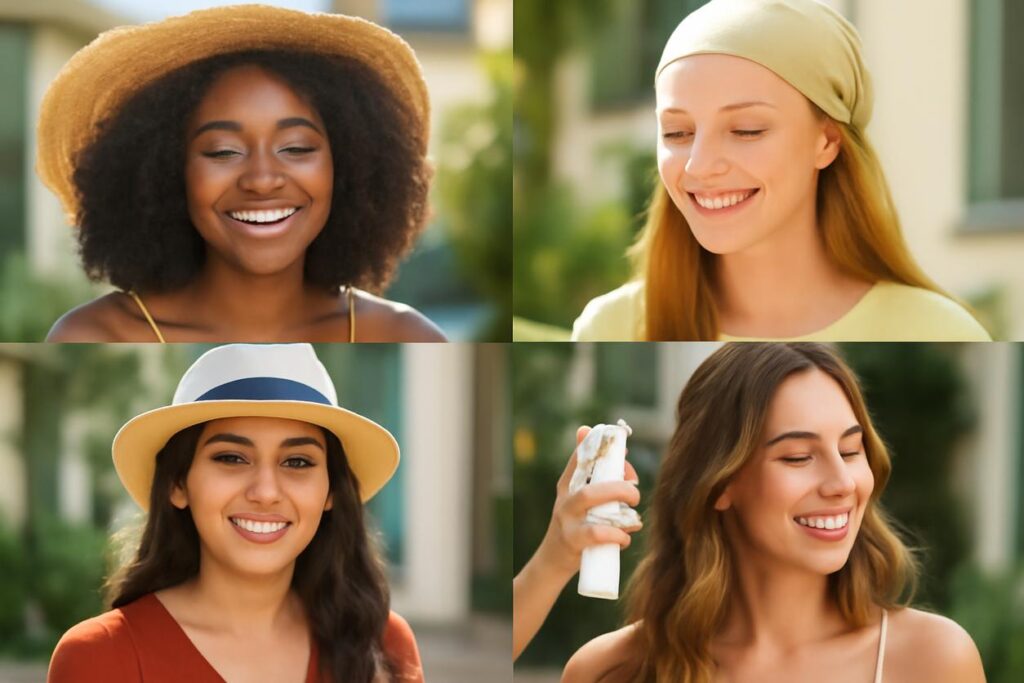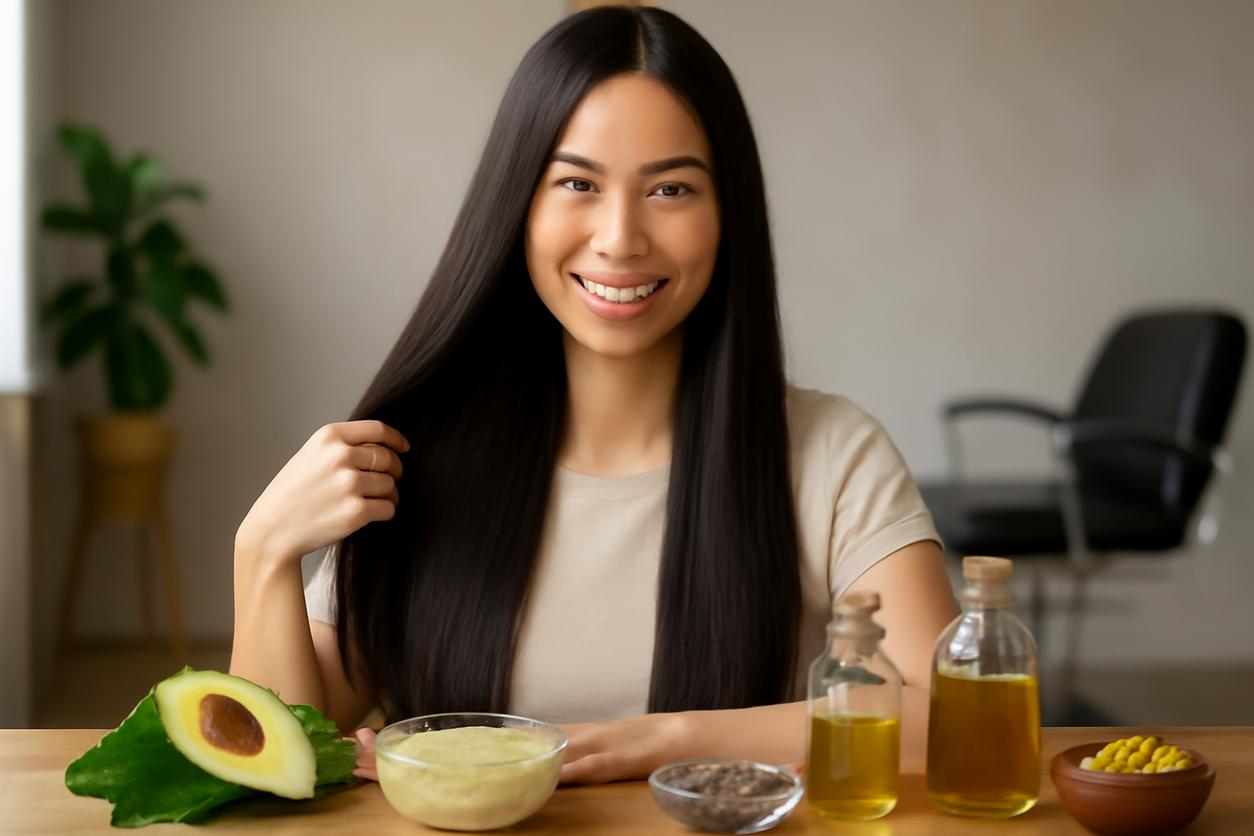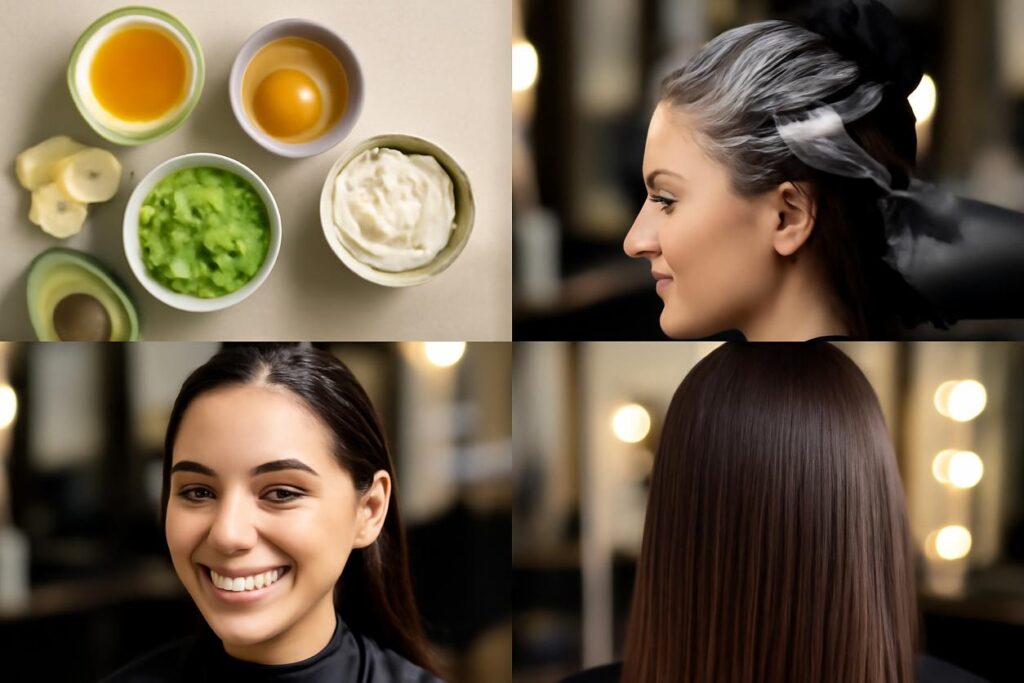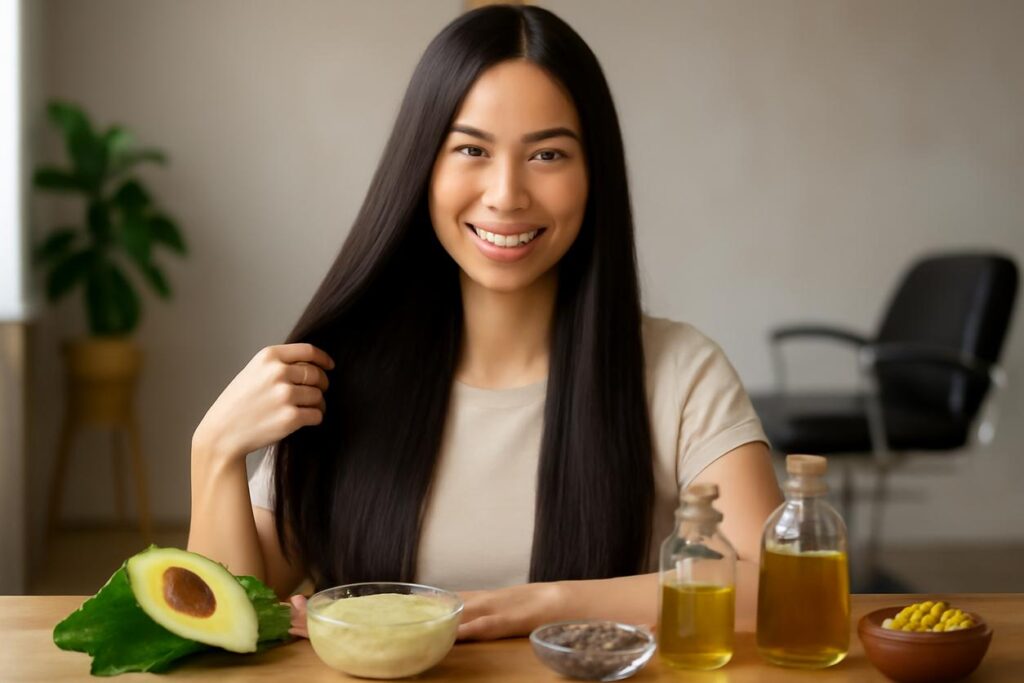Table of Contents
- Why Sunlight Harms Hair
- How to Recognise UV Damage
- Daily Habits to Minimise Sun Exposure for Hair
- Protective Hairstyles and Physical Barriers
- Choosing Products That Offer UV Defense
- Natural and DIY Approaches
- Colour Treated Hair and Extensions in Sunlight
- Sample Routines by Hair Type
- Frequently Asked Questions
- References and Further Reading
We diligently apply sunscreen to our skin before heading outdoors, but what about our hair? Just like skin, our hair is vulnerable to the damaging effects of the sun. Prolonged exposure can lead to dryness, colour fading, and brittleness. This guide offers a complete overview of UV protection for hair, combining scientific insights with practical, everyday strategies. We will explore how to identify sun damage, implement protective habits, and choose the right products to keep your hair healthy, vibrant, and resilient against the sun’s rays.
Why Sunlight Harms Hair
While a little sunshine can feel great, the sun emits powerful UV radiation that can significantly degrade the health and appearance of your hair. Unlike the immediate and noticeable effect of a sunburn on the skin, sun damage to hair is a gradual process. The structural integrity of each hair strand is compromised over time, leading to visible and textural changes that are often mistaken for general wear and tear.
How ultraviolet radiation affects hair proteins and pigments
The primary culprits behind sun damage are UVA and UVB rays. Understanding their specific effects is key to effective UV protection for hair.
- UVA Rays (320-400 nm): These rays have a longer wavelength and penetrate deeper into the hair shaft. They are primarily responsible for colour degradation. UVA radiation oxidizes the melanin pigments in your hair, which is why natural and colour-treated hair can become lighter, brassy, or faded after sun exposure.
- UVB Rays (280-320 nm): These rays have a shorter wavelength and primarily affect the hair’s surface and internal structure. UVB radiation leads to the loss of hair proteins, most notably keratin. Keratin is the fibrous protein that gives hair its strength and elasticity. When it breaks down, the hair’s protective outer layer, the cuticle, begins to crack and lift, resulting in weak, brittle strands.
This combined assault on proteins and pigments strips the hair of its natural defenses, leaving it porous, dry, and prone to breakage. The more exposure your hair has, the more pronounced this damage becomes.
How to Recognise UV Damage
Recognising the signs of sun damage early is the first step toward restoring your hair’s health. The symptoms can be subtle at first but will worsen with continued, unprotected exposure. Pay close attention to how your hair looks and feels, especially after spending extended time outdoors.
Visual and tactile signs to watch for
If you notice several of the following signs, it’s likely your hair is suffering from UV damage:
- Dryness and Brittleness: Sun-damaged hair loses its natural moisture and oils, feeling rough and straw-like to the touch. It may snap easily when you brush or style it.
- Colour Fading: Your natural or dyed hair colour may appear significantly lighter, duller, or develop unwanted brassy (orange or yellow) tones.
- Split Ends and Frizz: The breakdown of the hair cuticle leads to split ends and a rough, uneven surface that appears frizzy and unmanageable.
- Loss of Shine: Healthy hair has a smooth cuticle that reflects light. When the cuticle is damaged by the sun, the hair appears dull and lacks its natural lustre.
- Thinning and Weakness: Over time, the protein loss can make hair strands feel thinner and weaker, leading to increased breakage.
A simple at-home test is the porosity test. Take a single strand of clean, dry hair and drop it into a glass of water. If it sinks quickly, your hair has high porosity, meaning the cuticle is likely damaged and absorbs water rapidly. This is a common sign of UV and other forms of damage.
Daily Habits to Minimise Sun Exposure for Hair
Effective UV protection for hair begins with simple, conscious choices you can make every day. You don’t need a complete lifestyle overhaul; small adjustments to your daily routine can significantly reduce your hair’s overall sun exposure.
Timing, shade and simple behavior changes
Integrating these habits, especially from 2025 onwards, will build a strong foundation for your hair care strategy:
- Avoid Peak Sun Hours: The sun’s UV rays are strongest between 10 a.m. and 4 p.m. Whenever possible, try to schedule outdoor activities, errands, or exercise outside of this window.
- Seek Shade: This is the easiest form of sun protection. Sit under an umbrella at the beach, walk on the shady side of the street, or enjoy a picnic under a tree. Any physical barrier between you and the sun helps.
- Use a Car Sunshade: If you spend a lot of time driving, remember that UVA rays can penetrate glass. While you may not get a sunburn, your hair is still being exposed.
Protective Hairstyles and Physical Barriers
Beyond daily habits, physical barriers are your most reliable defense against UV radiation. Covering your hair is a foolproof way to block harmful rays, and certain hairstyles can help by reducing the surface area exposed to the sun.
Hats, scarves and styling ideas for different hair lengths
A physical barrier is the ultimate tool for UV protection for hair. Consider adding these to your wardrobe:
- Hats: A wide-brimmed hat is the best option, as it protects your hair, scalp, face, and neck. Look for hats with a UPF (Ultraviolet Protection Factor) rating for certified effectiveness. A tightly woven fabric like canvas offers more protection than a loose straw hat.
- Scarves and Headwraps: A stylish and versatile option, scarves can be wrapped around your head or a ponytail to cover your hair completely. They are lightweight and easy to carry with you.
Protective hairstyles work by tucking away the most vulnerable parts of your hair, particularly the ends, and minimising the amount of hair that is directly exposed to sunlight.
- Buns and Top Knots: These styles gather all your hair and tuck the ends away, offering excellent protection for medium to long hair.
- Braids: A classic braid or French braids keep hair contained and reduce the exposed surface area.
- Twists: Similar to braids, twists are a great way to protect hair while keeping it neat.
Choosing Products That Offer UV Defense
While physical barriers are best, there are times when covering your hair isn’t practical. In these situations, hair products formulated with UV filters can provide an additional layer of defense. The market for products offering UV protection for hair is growing, but it’s important to know what to look for.
Ingredients to look for and label decoding
Unlike skin sunscreen, “hair sunscreen” is not an FDA-regulated category. This means you need to be a savvy shopper. Look for products like leave-in conditioners, serums, and styling sprays that contain ingredients known to absorb or block UV radiation.
Key ingredients that help protect hair include:
- UV Absorbers: Ingredients like benzophenone-4, ethylhexyl methoxycinnamate, and octyl salicylate work by absorbing UV radiation and converting it into less harmful energy.
- Antioxidants: Vitamins C and E, green tea extract, and sunflower seed oil help neutralise free radicals produced by UV exposure, reducing oxidative stress on the hair.
- Silicones: Ingredients like dimethicone can coat the hair shaft, providing a physical barrier that helps lock in moisture and offer some protection from environmental stressors, including UV.
When reading labels, look for phrases like “UV filter,” “sun protection,” or “colour protection,” as these often indicate the presence of protective ingredients.
Natural and DIY Approaches
For those who prefer a more natural approach or want to supplement their existing routine, some home remedies can offer a degree of UV protection. It is important to remember that these methods are complementary and should not replace primary protective measures like hats or specialised products, especially during prolonged sun exposure.
Home remedies that complement product use
Many natural ingredients are rich in antioxidants, which can help mitigate the damage caused by UV-induced free radicals. Think of these as supportive treatments rather than shields.
- Green Tea Rinse: Green tea is packed with antioxidants. Brew a strong cup of green tea, let it cool completely, and use it as a final rinse after conditioning your hair. Do not rinse it out.
- Aloe Vera Gel: Known for its soothing properties, pure aloe vera gel can be mixed with water in a spray bottle and spritzed onto hair to provide light hydration and a dose of vitamins.
- Certain Plant Oils: Some studies suggest that certain oils, like coconut oil and olive oil, have a very low, natural SPF. While not sufficient for primary protection, applying a small amount to your ends can help seal in moisture and provide a minimal barrier.
Colour Treated Hair and Extensions in Sunlight
If your hair is chemically treated, dyed, or you wear extensions, providing adequate UV protection for hair is non-negotiable. These hair types are significantly more susceptible to sun damage than virgin, untreated hair.
Extra precautions for dyed and treated hair
Chemical processes like bleaching, dyeing, and relaxing already compromise the hair’s cuticle. This pre-existing vulnerability is exacerbated by UV radiation, leading to accelerated damage.
- Accelerated Colour Fading: UV rays are notorious for breaking down artificial colour molecules. Red and copper tones fade the fastest, while blonde hair can turn brassy and brown hair can develop unwanted orange hues.
- Increased Brittleness: Since the hair is already in a fragile state, the protein degradation caused by UVB rays can lead to severe breakage and a straw-like texture.
- Extension Damage: Hair extensions, whether synthetic or human hair, are also prone to fading and drying out. Unprotected sun exposure can cause them to fade at a different rate than your natural hair, resulting in a mismatched look.
For this hair type, a multi-pronged approach is essential: always wear a hat during peak sun, use colour-safe products with dedicated UV filters, and incorporate deep-conditioning treatments to replenish lost moisture.
Sample Routines by Hair Type
Effective hair care is not one-size-fits-all. Your strategy for UV protection for hair should be tailored to your specific hair type. Below are some simple checklists to help you build a routine for the sunny days ahead, starting in 2025 and beyond.
Short checklist for fine, thick, curly and textured hair
Use these as a starting point and adjust based on your hair’s needs.
| Hair Type | Pre-Sun Exposure Checklist |
|---|---|
| Fine Hair |
|
| Thick Hair |
|
| Curly Hair |
|
| Textured/Coily Hair |
|
Frequently Asked Questions
Is UV protection for hair necessary even on cloudy days?
Yes. Up to 80% of the sun’s UV rays can penetrate clouds, so your hair is still exposed to potential damage. It’s a good habit to use a UV protectant product daily, regardless of the weather.
Can I use my regular body sunscreen on my hair?
It is not recommended. Sunscreens formulated for skin are typically thick, greasy, and can leave a heavy, sticky residue on your hair. It’s better to use products specifically designed for hair, which are lightweight and won’t weigh your strands down.
How often should I reapply a UV protectant hair product?
You should reapply a UV-protective hair product after swimming, sweating heavily, or after several hours of direct sun exposure. Think of it similarly to how you would reapply sunscreen to your skin.
Does the sun damage the scalp too?
Absolutely. Your scalp is skin and is highly susceptible to sunburn, which can damage hair follicles and even lead to skin cancer. The best protection for your scalp is a hat. If you can’t wear a hat, apply a sunscreen designed for scalps along your part line or use a powder sunscreen.
References and Further Reading
For more detailed information on hair health and the effects of ultraviolet radiation, we recommend these trusted resources:
- A scientific review on UV hair damage provides in-depth research on the photochemical and physical effects of sun exposure on hair.
- The World Health Organization offers a comprehensive overview of ultraviolet (UV) radiation and its effects on human health.
- For general hair care guidance, including tips on washing, styling, and dealing with common issues, this public health resource is invaluable.






